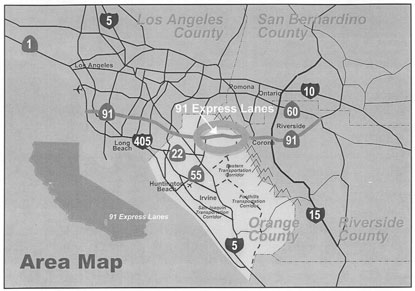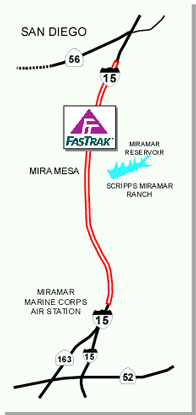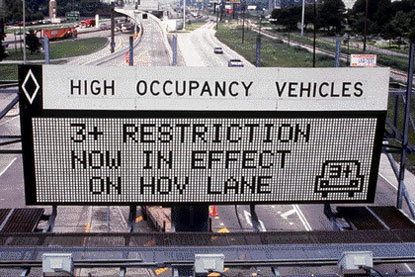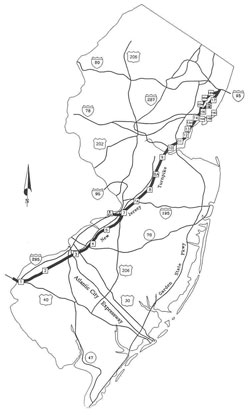|
|
|
MANAGED LANES: A Cross-Cutting Study
Chapter Three. Managed Lanes: State of the Art
The Introduction of Pricing Strategies
Value pricing, once known as congestion pricing, was introduced to transportation officials through a federal pilot program included as part of the Transportation Efficiency Act for the 21st Century (TEA-21). The pilot program allows agencies to work with the Federal Highway Administration (FHWA) to employ road pricing strategies, including the idea of charging motorists a toll for travel during the most congested times or offering a discount for traveling in the off-peak. Value priced lanes use pricing as the primary mechanism to regulate demand.
The program ushered in the use of High-Occupancy Toll (HOT) lanes as an operational strategy. HOT lanes take advantage of available unused capacity in the HOV lane by allowing vehicles that do not meet the minimum occupancy requirement to pay a toll for access to the lane(s). The price may be set in a regular toll schedule, it may change by time of day or day of the week, or it may change dynamically in response to the current level of congestion. HOT lanes use both vehicle eligibility and pricing to regulate demand.
Exhibit 5 illustrates the ways in which pricing can be used as a demand management strategy for managed lanes. The primary advantage of pricing over other forms of lane management is the demonstrated ability of variable tolling to actively managed demand. Variations in vehicle eligibility and access control as dynamic active management strategies have not been demonstrated in field application as pricing has.
| PRICE
Price refers to management that uses prices to regulate demand. |
HOT Lanes | HOT lanes give access to vehicles that do not meet occupancy requirements by assessing a toll for these vehicles. |
|
|---|---|---|---|
| Variable Toll Lanes | Toll lanes may charge a toll that fluctuates depending on time of day, day of week or amount of congestion in an attempt to more effectively distribute traffic. |
|
Highlights of Case Studies
An essential first step for the study team was defining the type of managed lane facilities that would be examined under this research effort. For the purposes of this study, the research team focused on state-of-the-art case study facilities that utilized pricing, but also demonstrated a combination of the other basic managed lane operational strategies: vehicle eligibility, and access control.
This chapter highlights several of the managed lane projects in operation around the country. The four selected case studies, which represent a geographical and operational cross section of managed lanes currently in practice, are:
- State Route 91 Express Lanes, Orange County, California
- Interstate 15 Express Lanes, San Diego, California
- Interstate 10 and US 290 HOT Lanes, Houston, Texas
- New Jersey Turnpike Dual-Dual Section, New Jersey
Each is unique in the operational strategy or combination of strategies that are used. The profiles of these projects, which were developed from published information and phone contacts, include five categories of questions that are integral in the success of the project. The five categories are:
- Concept Planning
- Project Planning and Design
- Operations
- Enforcement
- Public Outreach.
State Route 91
State Route 91 (SR 91) in California (Exhibit 6) was the first fully automated toll road in the world and the first toll road in the United States to vary tolls by the level of congestion on the roadway. The four-lane roadway, built within the median of SR 91, is 10 miles in length with no intermediate access. Two lanes are provided in each direction and they are separated from the mainlanes by plastic pylons and a painted buffer. The toll rates are set according to level of congestion typically experienced on the roadway, thereby making travel during the peak periods the most expensive time to travel. Although, the facility is open 24 hours a day, seven days a week and tolls are charged at all times, the operators use price in an attempt to shift vehicles out of the peak period.

Exhibit 6. SR 91 Express Lanes Boundaries (7).
Motorists that choose to use the lanes are notified of the current toll well in advance of the facility via dynamic message signs. The tolls are paid exclusively through electronic toll collection. Users of the facility must have an account and a transponder. The facility is also managed to encourage travel in high occupancy vehicles. Carpools with three or more occupants, motorcycles, zero-emission vehicles and vehicles with disabled person license plates are free at all times with the exception of the evening peak period in the peak direction, when HOVs are charged 50% of the posted toll. Again, price is used to encourage certain travel behaviors and conveyances.
The operators of the SR 91 Express Lanes have implemented a toll policy that is based on active management of the facility. The lanes are continuously monitored and this data is used the make adjustments to the tolls as necessary to keep the facility free-flowing. Hourly traffic volumes are monitored over a 12-week period. If vehicle volumes per hour, per direction approach levels were speeds become unstable or slow the tolls may be adjusted. The new toll rate will stay in effect for six months. If, after six months, it is determined that traffic volumes have fallen, creating excess capacity, the toll may be reduced. The operators of the facility are actively managing the lanes to optimize traffic flow.
Interstate 15, San Diego, CA
The I-15 Express Lanes in San Diego, California, is an eight-mile, two-lane reversible facility that stretches between State Route 52 and State Route 56. Exhibit 7 depicts the Express lanes boundaries. The lanes are separated from the mainlanes by concrete barriers. Access is only available at the termini. The lanes originally operated as HOV lanes but often had unused capacity available. The lanes operate Monday through Friday from 5:45 - 11:00 am in the southbound direction and 1:00 - 7:00 pm in the northbound direction. In 1996 the HOV lanes were converted to HOT lanes, where SOVs are charged to use the facility and HOVs travel in the lanes free of charge.

Exhibit 7. I-15 Express Lane Boundaries (5).
I-15 employs dynamic tolling, the first of its kind implemented. Toll rates typically vary from $ .50 to $ 4.00 but can rise as high as $ 8.00 during severely congested conditions. Technology deployed in the corridor allows for the assessment of current traffic conditions and the toll rate is adjusted dynamically to ensure free flow conditions in the express lanes. Dynamic message signs prior to the entrance of the facility alert drivers to the current toll. The drivers then have ample time to choose whether or not to enter the lanes and pay the toll. As with SR 91, all users must be registered and have an established FasTrak account. A FasTrak account allows tolls to be collected electronically. No manual or cash toll collection is accommodated. The average daily traffic on the Express lanes is between 25,000 and 35,000 vehicles.
I-10 and US 290, Houston, Texas
A slightly different pricing project has been implemented on I-10, also known as the Katy Freeway, and US 290, known as the Northwest Freeway, in Houston, Texas. The program is marketed under the name QuickRide. QuickRide began operating on the Katy Freeway in January 1998 and was expanded to the Northwest Freeway in 2000. The project was implemented as part of the Value-Pricing Pilot Project Program. The facility essentially operates as a HOT lane although SOVs are not allowed on the facility.
I-10, KATY FREEWAY
The HOV lane on the Katy Freeway is a one-lane reversible facility separated from the mainlanes with a concrete barrier with access allowed at intermediate locations in addition to the termini. The lane is 13 miles long and provides access to downtown Houston and the Galleria area from suburban communities west of the city. The HOV lane operates Monday through Friday from 6:00-11:00am in the inbound direction and 2:00-8:00pm in the outbound direction. Since 1986 the HOV lane operates with a 3+ restriction during the peak periods which are from 6:45-8:00am and 5:00-6:00pm. Exhibit 8 shows the dynamic message used to alert drivers of the restriction. The lane is also open from 5:00am - 8:00pm in the outbound direction on Saturdays and the same hours in the inbound direction on Sundays. There is a 2+ restriction on both these days. However, this 3+ restriction left unused capacity while allowing all HOV2s on the facility impeded operations. The Metropolitan Transit Authority of Harris County (METRO), working with the Texas Department of Transportation (TxDOT), and FHWA implemented tolling of HOV2s during the 3+ restriction to utilize the available capacity on the HOV lane.
US 290, NORTHWEST FREEWAY
Many of the same issues were encountered on the Northwest Freeway as well. By the late 1990s congestion on this 13.5 single lane reversible facility had caused speeds to slow to 20-30MPH in the HOV lane. This was particularly bad in the AM peak period.

Exhibit 8. Dynamic Message Board.
In early 2000 the occupancy requirement on the Northwest HOV was raised to 3+. This resulted in improved conditions on the facility but, as expected, additional capacity remained. Therefore, in November 2000 the QuickRide program was expanded to the Northwest HOV lane. The program is in effect during the 3+ restriction which is in the AM peak only from 6:45-8:00am.
The QuickRide program is operated much like the FasTrak program in California. HOV2s are required to establish an account and are issued a transponder. HOV2s that wish to travel on the facility during the 3+ restriction are charged $ 2.00 each way via their transponder. HOV 3+ carpools are not required to establish an account nor are they required to have a transponder. If motorists do have a transponder and are traveling in a 3+ carpool the transponder is inserted into a silver static bag to prevent it from being read and a toll assessed.
New Jersey Turnpike
The New Jersey Turnpike is a limited access facility that utilizes a variety of management techniques to optimize flow. The entire toll facility is 148 miles long and connects New York to Philadelphia. The entire turnpike is shown in Exhibit 9. In the 1970s a 32-mile segment of the roadway was expanded into two separate roadways. The objective of the dual-dual roadway was to improve operations and safety by separating heavy vehicles from light vehicles and to increase capacity in the most heavily traveled section of the Turnpike. It was also intended to provide greater flexibility for using the roadway during periods of heavy congestion such as a major incident, since changeable message signs technology could be applied to warn approaching drivers and divert them to the less-congested roadway.

Exhibit 9. New Jersey Turnpike (6).
The inside lanes of the dual-dual roadway are for automobiles only while the outer lanes accommodate all vehicles types. These lanes are separated from the outer lanes by concrete barriers. Each part of the roadway has its own entrance and exit ramps and there are periodic openings in each of the roadways to allow traffic to be diverted from one facility to the other as conditions may warrant. Between Interchanges 11 and 14, the left-most lane of the outer roadway is designated as a HOV lane between the hours of 6 a.m. and 9 a.m. in the northbound direction and between 4 p.m. and 7 p.m. in the southbound direction. The HOV lanes are reserved for cars and vans carrying three or more persons and to all buses and motorcycles. These lanes act as general-purpose lanes at times other than the peak and are open to all traffic at these times.
The Turnpike Authority has recently implemented a value pricing incentive to shift travel out of the peak. Customers using E-ZPass electronic toll collection, traveling in the off-peak hours (hours other than 7:00-9:00 a.m. and 4:30-6:30 p.m. Monday through Friday) receive a 20 percent discount off the toll rate.
This project differs from the others, foremost, in that the NJTP had adequate right-of-way to expand the facility and the financial ability to do so. The Northeast has a much longer history and familiarity with tolling than do other parts of the country. The corridor exists primarily to serve long distance trips. In fact, 35 percent of its toll revenue is derived from out-of-state motorists. The Authority continues to make improvements to the corridor that furthers the management capabilities of the facility. A recent interchange improvement, scheduled for completion in 2004, will provide travelers with direct access to a transit transfer station.
Previous | Table of Contents | Next